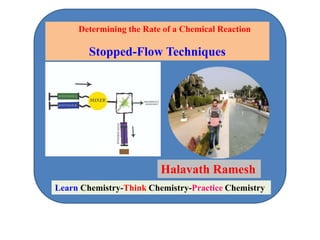
Determining the rate of a chemical reaction(Stopped-flow techniques)
- 1. Determining the Rate of a Chemical Reaction Stopped-Flow Techniques Halavath Ramesh Learn Chemistry-Think Chemistry-Practice Chemistry
- 2. Kinetic methods are the measurement of the analytical signal is made under dynamic conditions in which the concentrations of reactants and products are changing as a function of time. Fast reactions are the chemical reactions which take place at a very fast rate. These reactions can take place in seconds or in minutes. In general the reactions between ionic compounds are fast. Chemical kinetics, also known as reaction kinetics, is the branch of physical chemistry that is concerned with understanding the rates of chemical reactions.
- 3. Determining the rate of a chemical reaction, experimentally •Chemical methods •Physical methods •Stopped-flow techniques •Flash photolysis techniques •Perturbation-relaxation methods
- 4. Introduction Stopped-flow is a lab technique for studying fast chemical reactions. The stopped-flow technique was developed in the 1940s by modification of the continuous flow method with the principal advantage of more economic use of reagents. A stopped-flow instrument is a rapid mixing device used to study the chemical kinetics of fast reactions in solutions. The stopped-flow technique allows for the evaluation of solution based kinetics on a milliseconds timescale with a very small volume of reactants used. Many methods for kinetic studies are based on the measurement of a change in the concentration of a reagent or product as a function of time after the reagents have been mixed.
- 5. This approach requires that the process of interest be slow enough to give a reaction time that is longer than the time needed for reagent mixing and instrument activation. However, many biological interactions can occur within seconds (s) or milliseconds (ms), a fact which has limited the application of many traditional kinetic methods to such systems. Detection in stopped-flow analysis can be accomplished by using various methods that are able to selectively monitor a reagent or product in the reaction. Absorbance and fluorescence are two common detection methods that are employed for this type of experiment.
- 6. Mechanism This technique involves two reactants hold in separate reservoirs that are prevented from freely flowing by syringe pumps. The reaction is initiated by depressing the reactant syringes, and thus releasing the reactants into the connecting “ mixing chamber” where the solutions are mixed. The reaction is monitored by observing the change in absorbance of the reaction solution as a function of time. As the reaction progresses it fills the “ stop syringe “ which then expands until it hits a block at the point when the reaction has reached a continuous flow rate, there by stopping the flow and the reaction, and thus allowing the researcher to calculate the exact initial rate of reaction. Stopped-flow technique works because within millisecond of combining the two reactants the absorbance can be read.
- 7. In addition the stop syringe assures for a steady rate of flow pass the spectrophotometer so that reactants are being added to solution and forming products at a consistent rate. After perhaps a few milliseconds the observation cell is filled by a piston linked to a sensing switch that triggers the measuring device and the flow is stopped suddenly. For studied different forms of spectroscopy and scattering of radiation are common methods used. The dead time is the time between the end of mixing the two solutions and the beginning of observation of the kinetics of the reaction. The usual dead time of a stopped flow apparatus is 1-2 milli seconds. A stopped- flow instrument coupled to either a circular dichroism spectrometer or a fluorescence spectrometer is often used in the field of protein folding , to observe rapid unfolding and or refolding of proteins.
- 8. Model: SFM-20 Stopped-flow is one of a number of techniques used to study the kinetics of reactions of in solution. It is extensively used to study biomolecular interactions, kinetics and fast reaction mechanisms typical of many reactions in chemical and biological systems. It is also used in the field of protein folding to observe rapid unfolding and/or refolding of proteins. Two reactant solutions are rapidly mixed by being forced into a mixing chamber, and then through an observation cell.
- 9. At some point in time the flow is suddenly stopped and the reaction monitored using a suitable spectroscopic probe, such as absorbance, fluorescence or circular dichroism . The change in the spectroscopic signal as a function of time is recorded. The SFM-20 is a high performance, modular stopped-flow system, designed for single mixing rapid kinetics applications. Its mixing ratio ranges from 1:1 to 1:40 , dead time 0.6ms with the micro volume cuvette. It is compatible with MOS-200/M,MOS-450/AF-CD,MOS-DA. The signal detection is performed by a photomultiplier directly mounted on the stopped-flow and connected to its control unit. The photomultiplier can be attached at 180A° of the light source or at 90A° allowing absorbance or fluorescence measurements(both at the same time using an optional additional detection channel). For fluorescence measurements standard filters can be installed in front the photomultiplier tube inside the holder.
- 14. Figure 36.3 Schematic of a stopped-flow experiment. Two reactants are rapidly introduced into the mixing chamber by syringes. After mixing chamber, the reaction kinetics are monitored by observing the change in sample concentration versus time, in this example by measuring the absorption of light as a function of time after mixing.
- 22. Advantages of stopped flow method: 1. Volume of reagent used is very little. 2. A permanent recorder can record the progress of the reactions as a wide range. 3. This method is not affected by the rate and characters of the flow.